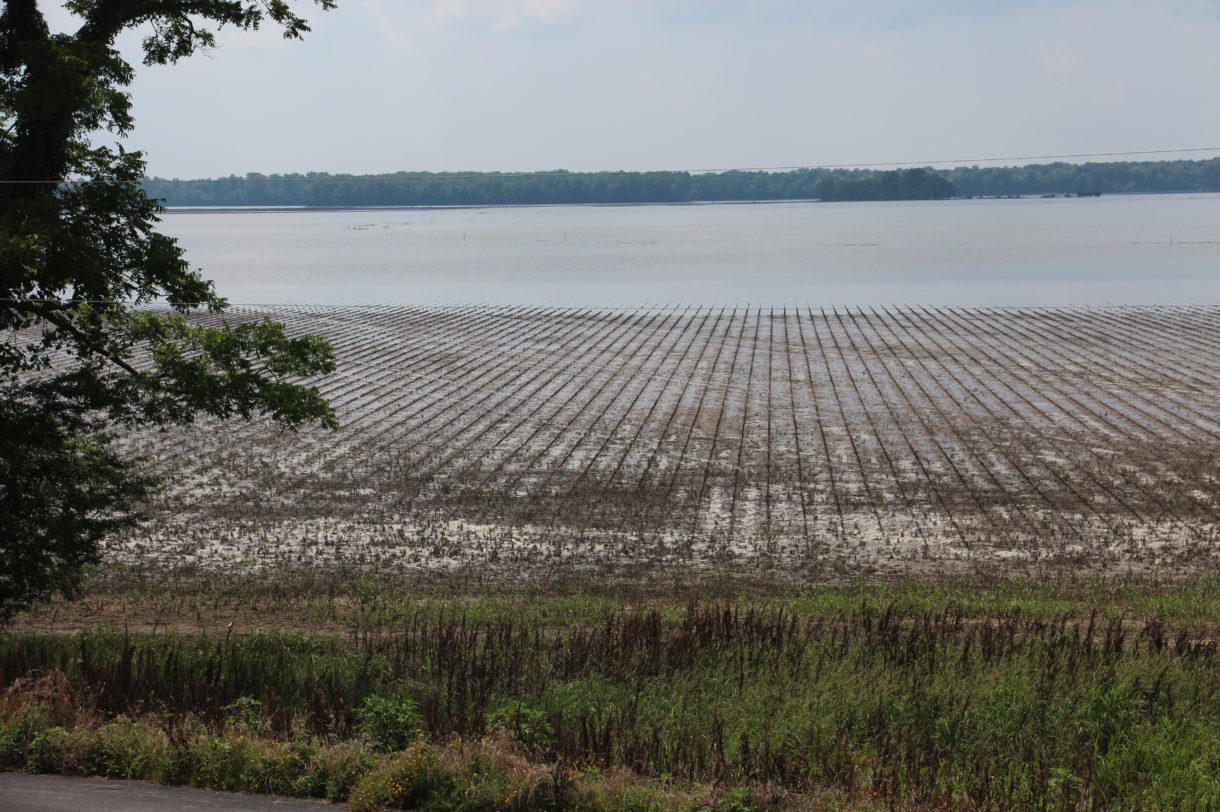Robert Henry is driving along the top of a Mississippi River levee, giving me a tour of land where he’d love to be planting soybeans right now. We’re just east of New Madrid, Mo.
“Smells kind of raunchy, doesn’t it?” he says.
From the window of Henry’s truck, I see what looks like a swamp, with trees standing in water. Then we make a turn, and suddenly, as far as I can see, there’s water. It covers a wide flood plain between the main river channel and the levee. This is where Henry normally grows his crops.
“Thousands and thousands of acres,” Henry says. “Some of the best land in the world.”
Henry won’t grow anything here this year. He even has a tractor and harvesting equipment stranded on an island out in the middle of the river.
But here’s the good news: He’ll get a check anyway — a payout from his crop insurance. It won’t be as much money as he’d have gotten from a soybean crop, but it’ll help him get by, “which is better than going under, you know?” he says.
Most farmers who grow big commodity crops like corn, soybeans and wheat buy crop insurance. It’s a good deal for them; the federal government actually covers about 60 percent of the cost of the premiums.
In fact, the federal government spends, on average, about $8 billion a year subsidizing crop insurance for farmers.
That number could be a lot bigger this year. Officials with the U.S. Department of Agriculture are expecting up to $1 billion in “prevented planting” payments to farmers in Henry’s situation. At the end of the season, more claims will arrive from farmers who planted seeds but ended up with poor harvests.
Some people fear that this year’s flooding is a taste of the future. Henry is hoping that it’s not. “It could be global warming, but I don’t think so,” he says. “I think we’re in a cycle of wet, and we’ll cycle out of it and we’ll be dry again.”
There are billions of dollars riding on this. Scientists, of course, say climate change is happening, although the precise effects — for example, on rainfall in the Midwest — are harder to predict.
A team of researchers at the USDA just released a study of how the changing climate could affect those crop insurance payouts.
“We used five different climate models, some of which are more optimistic and some more pessimistic in terms of warming and precipitation,” says economist Andrew Crane-Droesch, who led the research.
Generally, the models show a future, 40 to 80 years from now, in which farmers across the U.S. will bring in smaller harvests of the country’s biggest crops — corn and soybeans. The drop in crop yields is projected to be particularly large in non-irrigated land across the South.
This sounds bad, and it probably is for anyone who needs corn or soybeans. But for farmers, it may not be. Smaller harvests mean higher prices. “To the degree that climate change lowers production, it will increase the value [of the harvest], because of basic supply and demand,” says Crane-Droesch.
This is the first reason that the government could be paying bigger subsidies for crop insurance premiums in the future; it would be insuring harvests that would become more valuable.
In addition, the models show more volatility in the weather. The good years are better; the bad years worse. This means more farmer claims and government payouts for bad harvests.
Crane-Droesch is quick to point out that these are not firm predictions. His economic models disregard all sorts of complicating but important factors. They don’t consider the effects of international trade, for instance.
“There’s just a lot of stuff that we can’t capture. That’s why this work is only the beginning,” he says. “There’s a lot more to do on top of this.”
His study is attracting attention though, partly because there’s a risk that this type of work may not continue — at least not right away, or not within the USDA.
The USDA’s Economic Research Service, where Crane-Droesch and his colleagues work, is getting relocated from Washington, D.C., to the Kansas City region. Agriculture Secretary Sonny Perdue says it’ll save money and bring “important USDA resources closer to many stakeholders.”
Critics call it an attack on independent research. The move, they say, has been carried out in such a rush that it’s forcing employees to quit rather than uproot their lives.
Most authors of the new report either have left the agency already or are planning to do so.
9(MDEwNzczMDA2MDEzNTg3ODA1MTAzZjYxNg004))
